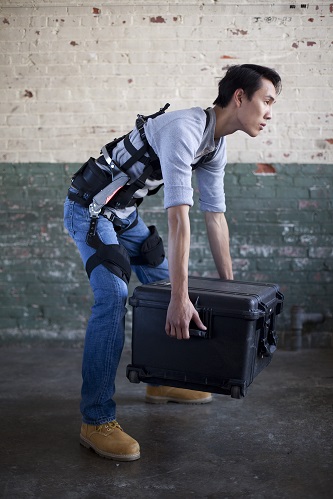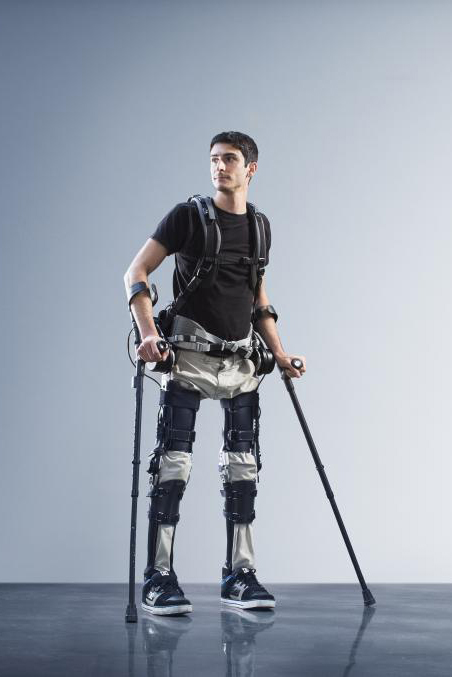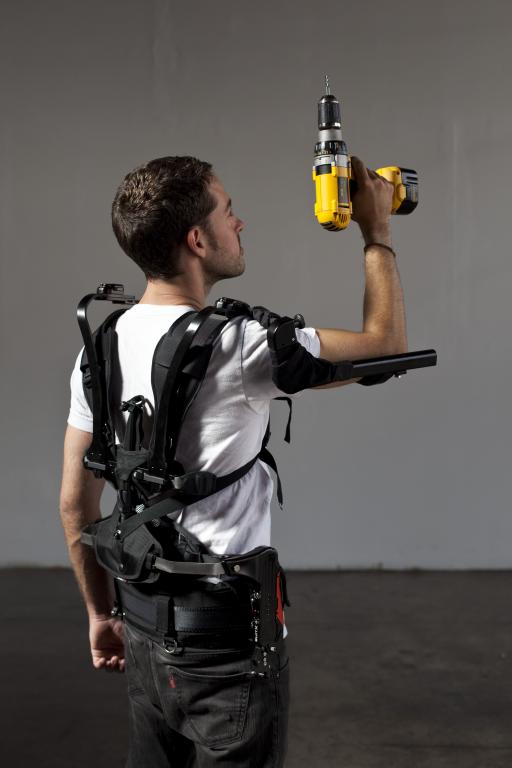
Industry giants around the world are investing in autonomous vehicles. In Australian mines, Rio Tinto employs hundred-ton driverless trucks to transport iron ore. Volvo is seeking volunteers willing to be ferried around London’s winding streets with no one at the wheel. MIT researchers recently determined the most efficient way for driverless trucks to transport goods — something called “platooning.” The guy behind Google’s first self-driving car now runs autonomous trucking startup Otto in San Francisco.
Truckers may be among the most vulnerable to automation but they’re certainly not alone. Over the past year we’ve seen an AI attorney land a job at a law firm, Hilton hire a robotic concierge, and even — ahem — “robojournalists” cover the U.S. election. As far as we know, none of these bots have caused a human to get laid off — but they’re telling of things to come.
“We’re trying to blur the distinction between electronic circuits and neural circuits.”
The so-called Fourth Industrial Revolution will transform the job market, eliminating over five million jobs in the next five years, according to the World Economic Forum. So what do we do, as humans? Augment ourselves.
Augmentation was the running theme of this year’s Bodyhacking Conference in Austin, Texas. Attendees lined up for RFID implants, speakers demonstrated bionic body parts, grinders exhibited artificial senses, and an entire fashion show put “smart” apparel on display. Most of the augmentations were idiosyncratic and wouldn’t make a potential employee more competitive in the future job market (except, perhaps, for documentary filmmaker Rob “Eyeborg” Spence’s prosthetic eye camera). With this in mind, we explored the ways in which augmentation may safeguard us from automation.
Augment our brains
Humans have extraordinary brains — the best in the animal kingdom — but in AI we’ve created minds that exceed our own in many ways. Sure, humans still hold the title for outstanding general intelligence, as today’s AI systems excel at the specific tasks they’re designed for, but algorithms are advancing fast. Some are even learning as they work. A year ago, AI experts thought it would take at least another decade for an algorithm to defeat a top-tier Go player. And then this happened.
Entrepreneur, futurist, and headline-staple Elon Musk is so concerned about AI that he co-founded the billion-dollar nonprofit OpenAI to promote “friendly” AI in December 2015. Six months later, he told a crowd at the Code Conference he wants to develop a digital neural layer — colloquially called “neural lace” — to augment humans on par with AI. He echoed these comments at the World Government Summit in Dubai on Monday, suggesting that such a symbiosis could potentially solve the “control problem and the usefulness problem” likely to face future humanity.

The concept is relatively simple: A neural lace is some sort of material that boosts the brain’s ability to receive, process, and communicate information. It’s an extra layer, perhaps a kind of electronic mesh, that physically integrates with the brain and turns the mind into a kind of supercomputer.
If this sounds like science fiction, that’s because it is. Or it was. The term was first coined by sci-fi author Iain M. Banks in his Culture series.
But almost exactly one year before Musk made his comment at the conference, a team of nanotechnologists at Harvard University published a paper called “Syringe-injectable electronics” in the journal Nature Nanotechnology, in which they described an ultra-fine electronic mesh that can be injected into the brains of mice to monitor brain activity and treat degenerative diseases. The possibility for such a material to augment the brain’s input-output capacity was too enticing to overlook.
“We’re trying to blur the distinction between electronic circuits and neural circuits,” co-author Charles Lieber told Smithsonian Magazine. “We have to walk before we can run,” he added, “but we think we can really revolutionize our ability to interface with the brain.”
Musk hasn’t kept completely quiet about his neural lace aspirations either. In August he told an inquisitive Twitter follower that he was “making progress” on the project. In January he said an announcement may come this month.
A functioning neural lace is still realistically many years off, but augmented by such a device, humans could conceivably compete with AI at computational tasks currently left to machines, while maintaining our high levels of intuition, decision making, and general intelligence. We’re already cyborgs. With smartphones and the internet as external brains, we boast superhuman intelligence. But analog outputs like typing and speech are slow compared to digital speeds. Imagine listing under the skills section on your résumé the ability to query a database, receive a response, and relay that information to a colleague in the fraction of a second it takes Google to display search results. It would make you a desirable candidate, indeed.
Augment our bodies
As robust as we are in mind, humans are desperately delicate in body. We’re fleshy, fragile things, prone to break and tear under pressure. Robots, on the other hand, are rugged, and capable of tackling strenuous tasks with relative ease.
But robots are also fairly inflexible. Where a human can seamlessly transition from one action to another, machines tend to do just one thing well and need to be recalibrated to perform new tasks. Enter exosuits. Fitted with these powered external skeletons, humans assume superhuman strength while limiting risk of injury associated with bending and lifting. Think Iron Man or the metallic gear worn by Tom Cruise and Emily Blunt in Edge of Tomorrow.
We’re fleshy, fragile things, prone to break and tear under pressure.
Like neural lace, these suits aren’t stuck in science fiction. Engineers at Hyundai, Harvard, and the United States Army are actively developing systems to serve paraplegics, laborers, and soldiers alike.
“What I’ve been working on in my lab for years is to combine the intelligence of the [human] worker with the strength of the robot,” Homayoon Kazerooni, director of the Berkeley Robotics and Human Engineering Laboratory, told Digital Trends. “Robots are metal, they have more power than a human. Basically, the whole thesis is to combine human decision making, human intelligence, and human adaptability with the strength and precision of a robot.”
Through his robotics research, Kazerooni founded SuitX, a company that created the PhoeniX medical exoskeleton for patients with spinal cord injury and a modular, full-body exosuit called the Modular Agile Exoskeleton (MAX).
“We use robotic devices where we have repetitive tasks,” Kazerooni said. “Anything that’s dangerous we also automate. These are structured jobs.”
MAX features three components: backX, shoulderX, and legX, each of which assists its titular region, minimizing torque and force by up to 60 percent.
“These machines reduce forces at targeted areas,” Kazerooni said. “It’s basically supporting the wearer, not necessarily from a cognitive point of view by telling workers how to do things, but by letting the workers do whatever tasks they’ve done in the past with reduced force.”
Kazerooni recognizes that machines may someday be so cheap and efficient that human workers simply become an expensive liability. Until then, the best way to keep laborers safe, productive, and employed may be to augment their physicality.
“The state of technology in robotics and AI is not to the point that we can employ robotics to do unstructured jobs,” he added, “which require a [human] worker’s attention and decision making. There’s a lot of unstructured work we can’t yet fully automate.”
Across the country, in the Harvard Biodesign Lab, a team of researchers are developing a softer side of exosuits.
Packed with small motors, custom sensors, and microprocessors, these soft wearable robots are designed to work in parallel with the body’s muscles and tendons to make movement more efficient. In a recent paper published in the journal Science Robotics, the interdisciplinary Harvard team demonstrated an almost 23 percent reduction in effort with its exosuit compared to unaided walking.
“It’s going to be a very difficult time for all human workers.”
The Biodesign Labs has so far been working with DARPA to develop exosuits to help soldiers carry heavy loads over long distances. However, project lead Ignacio Galiana thinks the suit can find applications beyond the battlefield.
“Factory workers in the automotive, naval, and aircraft industry have to move around very large and heavy parts,” he told Digital Trends. “Having a simple system they can wear under their normal pants can give them an extra strength.
“There’s now even a need for people to get packages delivered the next day, and so postal service personnel have a burden to move heavy packages around quickly,” he added. “If they could wear an exosuit that makes them faster and stronger, that could make their work much easier.”
Galiana doesn’t think humans and robots will compete directly for the same jobs. Instead, he sees them working in parallel — so long as humans can keep up with increasing physical demands.
“Human intelligence and decision making is critical in a lot of factory jobs, and the human brain is really hard to imitate in robots,” he said. “That will be key to keeping workers in the workplace. If you give extra strength to a factory worker who has that decision making and intelligence capabilities, you could see them being more effective and staying in work for longer, working alongside robots.”
Augment our skillset
Despite the progress that’s been made in the past few years, superhuman strength and intelligence lie somewhere in the hazy futurescape, inaccessible to most of today’s workforce and not exactly helpful when trying to figure out what humans should do now to safeguard themselves against automation.
For an immediate answer, we turned to Tom Davenport, co-author of Only Humans Need Apply: Winners and Losers in the Age of Smart Machines. In 2015, Davenport and co-author Julia Kirby published “Beyond Automation” in the Harvard Business Review, in which they laid out five practical steps workers may take to improve their employability against machines.
In their list, Davenport and Kirby encourage humans to stand out, whether by developing skills outside the realm of “codifiable cognition” (such as creativity) or learning the ins-and-outs of the machines themselves. (After all, someone needs to fix these things when they break down.) The authors’ advice is primarily meant for “knowledge workers,” however, not physical laborers — whom Davenport thinks will have a much more challenging transition in the future job market.
“I try to be optimistic,” Davenport told Digital Trends, “because I do think there are some valuable roles that humans can still play relative to these smart machines, but I don’t think it’s a time to be complacent about it. Any type of worker will need to work hard to keep up the right kinds of skills and develop new skills.”

As an example, Davenport points to our friends the truck drivers. “I don’t know how many of them will be willing to develop the computer-oriented skills to understand how autonomous driving works,” he said. And even if they did take an entry course in programming, what good would it do? Driving in general is a dying profession.
“I think it’s going to be a very difficult time for all human workers,” Davenport said. “I’m optimistic that many of them will make the transition but not all of them will. I’m definitely more pessimistic about certain jobs than others. Even for knowledge workers there will be some job loss on the margins but I believe there are a number of viable roles that they can play. That’s what a lot of my writing has been about — roles that knowledge workers can play that either involve working alongside smart machines or doing something they don’t.”
When Davenport says “smart machines,” he means narrow AI: systems that do a few specific things really well, such as recognizing faces, playing board games, and creating psychedelic art.
There’s another evolution of AI though, the kind that keeps Elon Musk and Stephen Hawking up at night: artificial general intelligence, which can basically do anything a human can intellectually.
What happens when these arise?
“All bets are off,” Davenport said.
Editors' Recommendations
- The future of automation: Robots are coming, but they won’t take your job
- Dear robots: If you come to steal our jobs, please take these ones first
- Robots aren’t coming to steal your job. They’re coming to improve it
- Top Oxford researcher talks the risk of automation on employment






